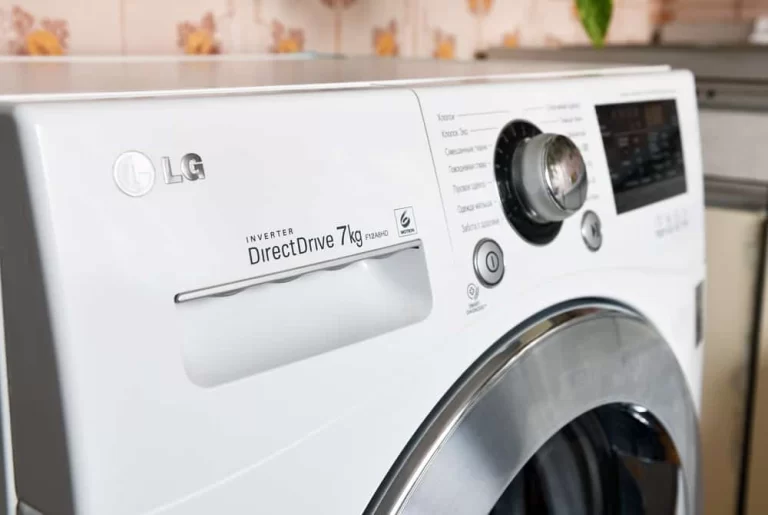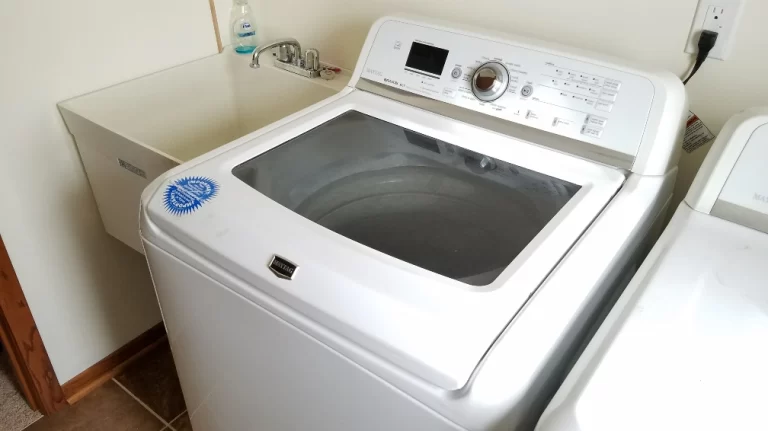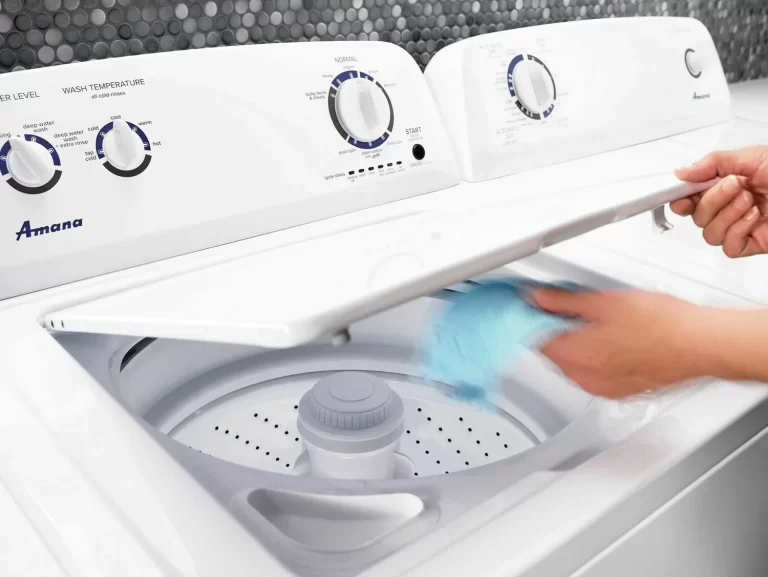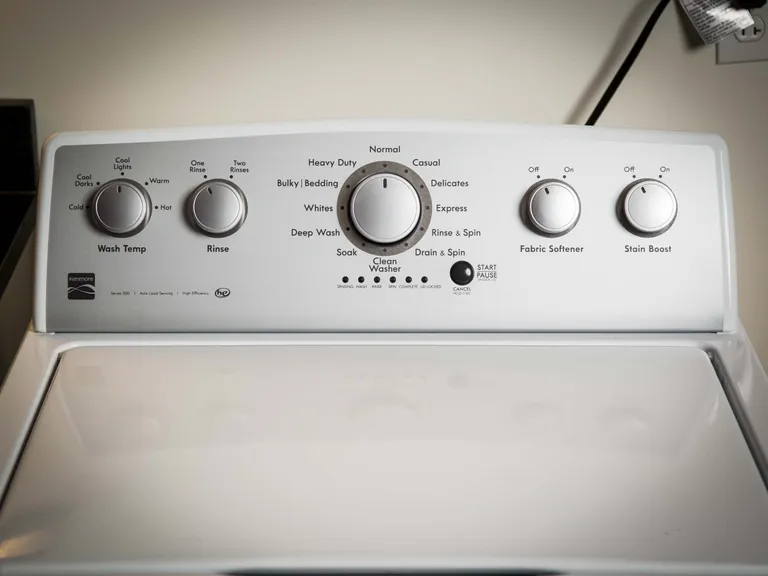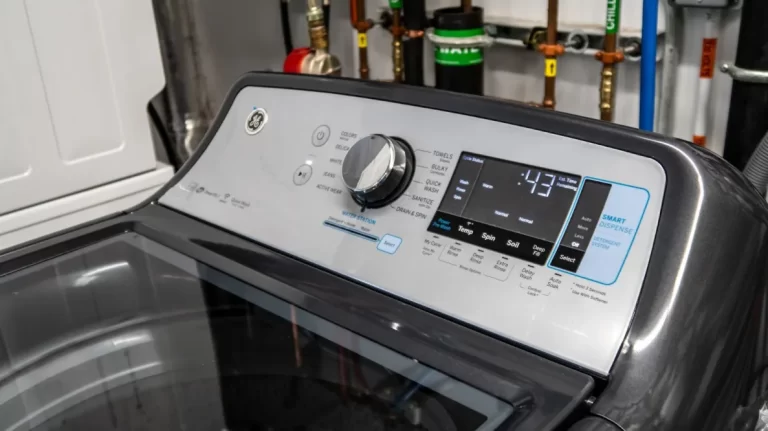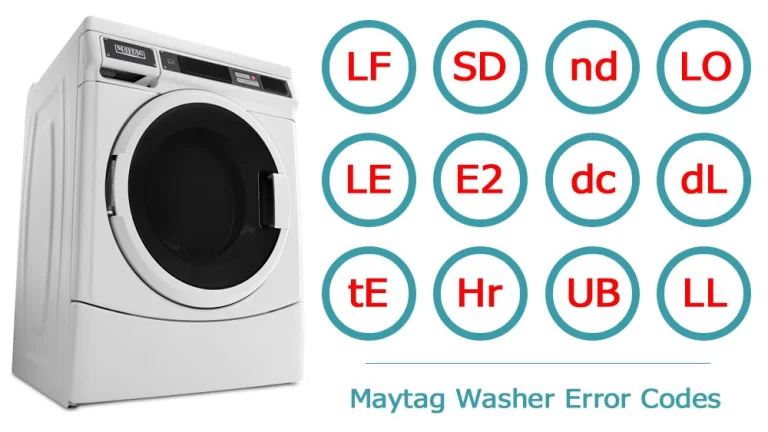Are you dealing with an Amana washer not draining? It can certainly disrupt your daily chores and make laundry a hassle. Amana washers are renowned for their reliability, but like all appliances, they may encounter issues over time. This comprehensive guide will help you understand, troubleshoot, and even fix common Amana washer problems related to draining.
If your Amana washer is not draining, it could be due to several issues such as a clogged drain hose, a faulty drain pump, or a defective lid switch assembly. Checking these components for blockages or malfunctions and fixing or replacing them as needed should solve the problem.
Quick Troubleshooting Guide
| Issue | Symptoms | Fixes |
| Drain Pump Failure | Loud noises, visible damage to pump, washer not draining | Inspect and replace pump if needed |
| Clogged Drain Hose | Washer not draining, water remaining in the drum | Disconnect, clear obstruction from hose, reconnect |
| Faulty Lid Switch Assembly | Washer not spinning, not draining, not starting | Check switch functionality, replace if faulty |
| Faulty Water-Level Pressure Switch | Washer overfills, underfills, or doesn’t proceed to drain and spin cycles | Inspect switch and its tube, replace if damaged |
| Worn Out Drive Belt | Washer doesn’t spin, doesn’t drain, loud noise during spin cycle | Locate and inspect drive belt, replace if damaged |
| Failed Timer | Washer doesn’t advance to next cycle, or cycles are longer or shorter than usual | Locate and inspect timer, replace if visibly damaged |
| Faulty Door Lock Motor and Switch Assembly | Washer door doesn’t lock, doesn’t proceed to drain and spin cycles | Inspect door lock assembly, replace if damaged |
| Clogged Coin Trap | Washer not draining properly, unusual noise during drain cycle | Locate coin trap, clean out any debris, replace if damaged |
| Blocked or Damaged Drain Pump Filter | Washer doesn’t drain, drains slowly | Locate, clean, and reinstall filter, replace if damaged |
| Damaged Motor Control Board | Washer doesn’t drain, doesn’t spin, doesn’t start | Inspect motor control board for visible signs of damage, replace if damaged, consult a professional if unsure |
Understanding Your Amana Washer
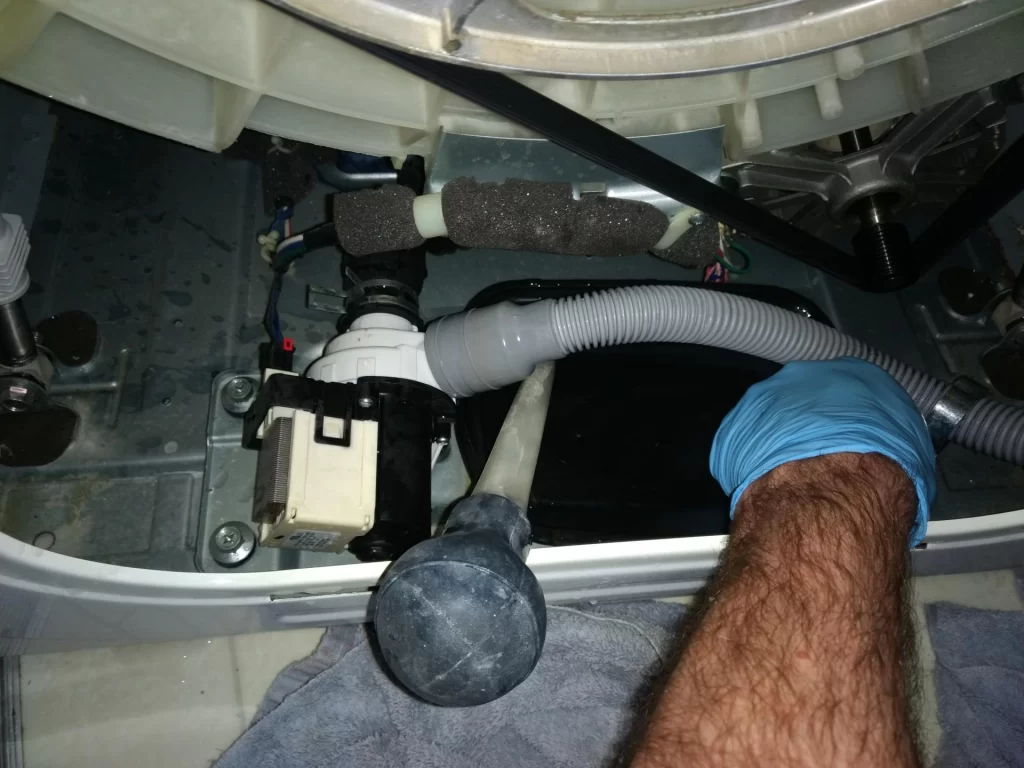
Amana, a trusted brand founded in 1934, has a long-standing reputation for quality appliances. Known for their innovative features and energy-saving designs, Amana washer models like the NTW4516FW and NFW5800HW have won acclaim from homeowners across the globe.
While these models differ in many aspects, they share a fundamental drainage system design that utilizes a drain pump, a drain hose, and a control system to effectively remove water from your clothes post-rinse.
Step-by-step Guide to Troubleshooting Amana Washer Not Draining
1. Drain Pump Failure
Problem: The drain pump is responsible for pumping water out of the washer drum during the spin cycle. It might fail due to wear and tear, a blown fuse, or a jam due to foreign objects.
Symptoms: Loud noises during the drain cycle, visible damage to the pump, or water not being pumped out during the spin cycle.
Fixes:
- Unplug the washer to ensure safety.
- Locate and inspect the drain pump for visible damage or blockages.
- If the pump is damaged, order a replacement part specific to your Amana washer model.
- Replace the pump following the instructions provided, or hire a professional if you’re unsure.
2. Clogged Drain Hose
Problem: The drain hose carries the used water from your washer to your home drainage system. If it gets clogged due to lint, small clothing items, or residue from detergents, it can prevent the washer from draining.
Symptoms: Washer is not draining correctly or at all, water remaining in the drum, an error message on your washer display.
Fixes:
- Unplug the washer for safety.
- Disconnect the drain hose from the washer.
- Use a long brush or a plumber’s snake to dislodge any blockages.
- Reconnect the hose, ensuring there are no kinks in it.
3. Faulty Lid Switch Assembly

Problem: The lid switch assembly is a safety feature that prevents the washer from operating when the lid is open. If it fails, the washer may not proceed to the drain or spin cycles.
Symptoms: The washer doesn’t spin, doesn’t drain, or doesn’t start at all.
Fixes:
- Unplug the washer.
- Locate the lid switch assembly and manually press it down.
- If it doesn’t make a clicking sound, it may be faulty.
- Order a replacement part specific to your Amana model and replace the switch assembly following the instructions provided or call a professional for assistance.
4. Faulty Water-Level Pressure Switch
Problem: The water-level pressure switch signals the washer to stop filling once it reaches a certain level. If it’s malfunctioning, the washer might not understand when to start the draining process.
Symptoms: The washer may overfill, underfill, or not proceed to the drain and spin cycles.
Fixes:
- Disconnect the washer from the power source.
- Access the pressure switch, often located behind the control panel.
- Check the switch and its tube for damage or disconnects. If you spot any, replace the part.
- If visually fine, consider testing the switch with a multimeter, or consult with a professional.
5. Worn Out Drive Belt
Problem: The drive belt connects the motor to the drive system to spin the tub. If it’s worn out or broken, the tub might not spin correctly, impeding the draining process.
Symptoms: The washer won’t spin, drain, or may make a loud noise during the spin cycle.
Fixes:
- Unplug the washer.
- Locate and inspect the drive belt for signs of wear or damage.
- If the belt appears damaged, replace it with a model-specific part.
6. Failed Timer
Problem: The timer controls most of the functioning cycles in the washer. If it fails, it might not signal the machine to start the drain cycle.
Symptoms: The washer doesn’t advance to the next cycle, or the cycles are longer or shorter than usual.
Fixes:
- Disconnect the power source.
- Locate the timer on your Amana washer, usually inside the main control panel.
- Inspect for visual damage. If damaged or burnt, replace the timer.
- If visual inspection doesn’t reveal any issue, consider hiring a professional to check the component electrically.
7. Faulty Door Lock Motor and Switch Assembly
Problem: This assembly ensures the washer door is locked during operation. If malfunctioning, the washer might not enter the drain cycle for safety reasons.
Symptoms: The washer door doesn’t lock, or the machine doesn’t proceed to the drain and spin cycles.
Fixes:
- Disconnect the washer from the power source.
- Locate the door lock motor and switch assembly.
- Inspect for visible damage. If damaged, replace it with a new assembly.
- If no visible damage, consider calling a professional for further diagnosis.
8. Clogged Coin Trap
Problem: Some washers have a coin trap to collect small items, like coins or buttons, from entering the drain pump. If it’s clogged, it can prevent proper draining.
Symptoms: The washer is not draining properly, or there’s an unusual noise during the drain cycle.
Fixes:
- Disconnect the power supply.
- Locate the coin trap, usually attached to the drain pump.
- Clean out any debris and reinstall it. If damaged, consider replacing it.
Blocked or Damaged Drain Pump Filter
Problem: The drain pump filter traps debris from entering the pump. If blocked or damaged, it might prevent the water from being pumped out.
Symptoms: The washer doesn’t drain or drains slowly.
Fixes:
- Unplug the washer.
- Locate the drain pump filter.
- Remove, clean, and reinstall it. If it’s damaged, replace it with a new one.
9. Damaged Motor Control Board
Problem: The motor control board provides power to the motor. If it’s damaged, it might not provide the necessary power for the drain pump to operate.
Symptoms: The washer doesn’t drain, doesn’t spin, or doesn’t start at all.
Fixes:
- Disconnect the washer from the power source.
- Locate the motor control board, usually at the bottom of the washer.
- Inspect for any visible signs of burn or damage. If found, replace it with a new board.
- If no visible signs are present, consult a professional to avoid any electrical mishaps.
Preventive Measures for Amana Washer Problems
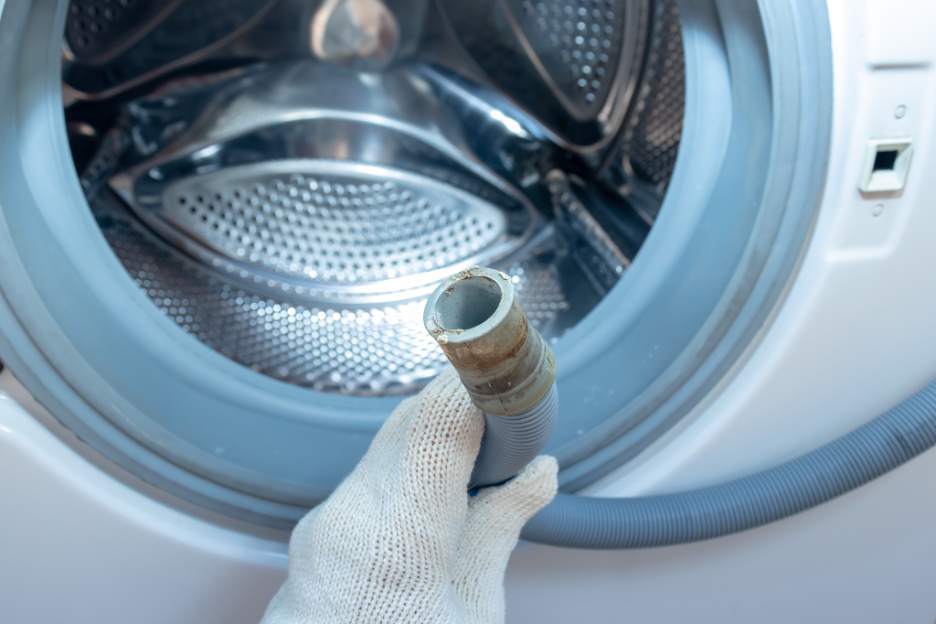
Maintenance is key to a long-lasting washer. Here are some tips:
Preventive measures can help prolong the life of your Amana washer and minimize potential issues, including drainage problems. Here are some guidelines to consider:
1. Regular Cleaning: Regularly clean your Amana washer, including the drum, door seal, and detergent drawer. This helps prevent buildup of detergent residues, dirt, or lint that could potentially lead to blockages or other issues. Running an empty hot wash cycle with a washing machine cleaner can also be beneficial.
2. Inspect and Clean Drain Hoses and Filters: Inspect the drain hose for kinks, leaks, or blockages every few months. A blocked hose or filter is a common cause of drainage problems. You can often clean these parts yourself, but make sure to refer to your user manual for specific instructions to avoid causing damage.
3. Use Appropriate Detergent in Proper Amounts: Using the wrong type or too much detergent can create excess suds, which can lead to a residue buildup that might block the drainage system. Always use HE (high-efficiency) detergent for HE washers like those from Amana, and follow the recommended dosage on the detergent packaging.
4. Don’t Overload the Washer: Overloading can strain the motor and drum, and it can also cause imbalances that prevent the washer from draining properly. Always follow the manufacturer’s guidelines regarding load size to ensure your washer runs efficiently.
5. Check Pockets Before Washing: Small items like coins, buttons, or other debris can get lodged in various parts of the washer, including the drain pump or the coin trap, and can cause the washer to stop draining. Always check the pockets of your clothing items before washing.
6. Regular Servicing: Just like a car, your washer needs regular servicing to keep it running smoothly. Having a professional technician inspect your washer can help detect and prevent potential issues.
7. Timely Replacement of Worn-Out Parts: Parts like the drive belt can wear out over time. Timely replacement of these parts can prevent further issues and potential damage to other components.
8. Correct Installation: Ensure your washer is properly installed. This includes level installation, correct water hose connection, and appropriate drain hose placement. Refer to the installation manual or hire a professional if you’re unsure.
By following these preventive measures, you can reduce the likelihood of problems with your Amana washer and help it run smoothly for many years.
Recognizing When to Seek Professional Help
1. Inadequate Understanding of the Issue: If you are unable to understand the exact nature of the problem, it’s a clear sign to seek professional help. Appliances like washing machines are complex, and guessing can lead to further problems.
2. Unsuccessful DIY Fixes: If you’ve tried troubleshooting the problem yourself without success, it’s time to hire a professional. Continued unsuccessful attempts may worsen the issue and even lead to other complications.
3. Electrical Problems: If the issue is electrical, such as faulty wiring, control board malfunctions, or switches not working, a professional should be involved. Attempting electrical repairs without the proper knowledge and safety precautions can be extremely dangerous.
4. Repeated Breakdowns: If your washing machine is frequently experiencing the same or different problems, a professional can provide a thorough check and detect if there’s a major underlying issue that needs addressing.
5. Significant Leaks or Floods: A small leak might be manageable, but significant water leakage or flooding is a serious issue that needs immediate professional attention. This could be due to major problems with internal components like the pump or hose connections.
6. Error Codes: Modern washing machines display error codes when there’s a problem. If you can’t find or understand the error code your machine is displaying, a professional will be able to diagnose and solve the issue.
7. Major Component Failure: Issues related to main components such as the motor, transmission, or drum require professional expertise. Replacing or repairing these parts often involves technical knowledge and specialized tools.
8. Age of Appliance: Older appliances may have obsolete parts or complex issues due to wear and tear over time. A professional will be better able to advise whether a repair or replacement is more appropriate.
FAQs
What regular maintenance can I perform to prevent my Amana washer from not draining?
Regularly check and clean the drain hose and coin trap to prevent clogs. Inspect the drive belt for wear and replace it as necessary. Finally, use the right amount of appropriate detergent to avoid residue buildup that could block the drain pump filter.
Is it safe to perform these fixes at home, or should I always hire a professional?
While many of these fixes can be performed at home, it’s important to always prioritize safety. If you’re uncomfortable or unfamiliar with how to perform any of these tasks, it’s best to hire a professional. Never try to repair an appliance while it’s still connected to the power source.
Where can I find replacement parts for my Amana washer?
Replacement parts for your Amana washer can be found at many online retailers, appliance parts stores, and sometimes directly from the manufacturer. Always make sure to purchase parts that are compatible with your specific washer model.
How can I tell if the issue with my washer not draining is due to a mechanical failure or a software issue?
Mechanical issues often have visible signs, such as a broken belt or a clogged hose. Software issues might cause the machine to act erratically, like skipping cycles or displaying error codes. Consulting your washer’s user manual or hiring a professional can help you diagnose the issue correctly.
What are the common error codes displayed by Amana washers when they have a draining problem, and what do they mean?
The error codes can vary based on the model of your Amana washer. For example, an “nd” code indicates a no drain issue, which could point to a clogged drain or a faulty pump. Always refer to your washer’s user manual for a full list of error codes and their meanings.
Conclusion
Understanding the reasons behind your Amana washer not draining and knowing the possible solutions empowers you to take control of the situation. Whether it’s a DIY fix or recognizing when to call a professional, this comprehensive guide aims to keep your laundry routine running smoothly. Remember, regular maintenance and timely repairs enhance the longevity of your washer.

